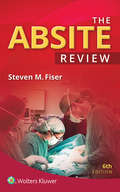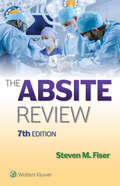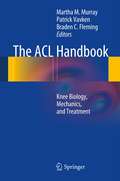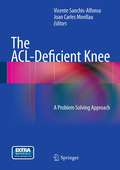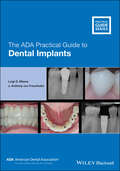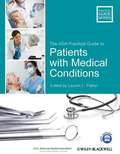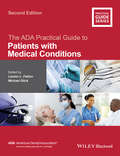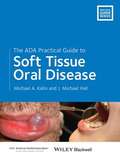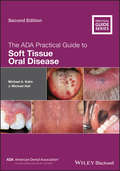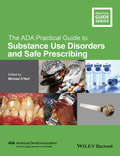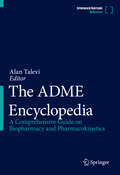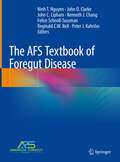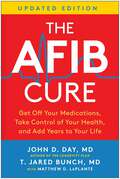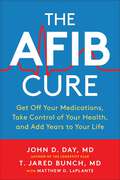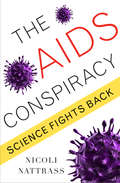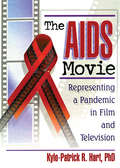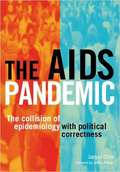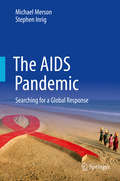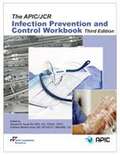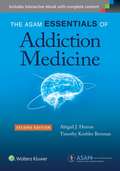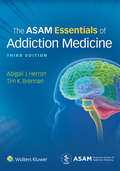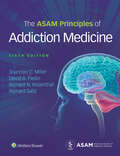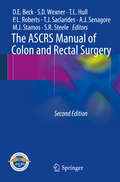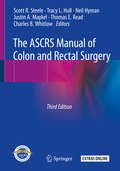- Table View
- List View
The ABSITE Review
by Steven M. FiserThe first outline-style ABSITE review book is still the best! The ABSITE Review, 6th Edition, remains your #1 choice for effective, efficient review for this critically important exam. Written in a high-yield, memory-prompting outline format, Dr. Fiser’s concise handbook covers every topic on the American Board of Surgery In-Training Examination, thoroughly updated for today’s residents. It provides a rapid review of essential surgery information with sufficient explanation to build knowledge and confidence as you prepare for the ABSITE.
The ABSITE Review: High Yield Study Guide
by Steven M. FiserWritten in a high-yield, memory-prompting outline format, Dr. Steven Fiser’s The ABSITE Review, 7th Edition, covers every topic on the American Board of Surgery In-Training Examination, now thoroughly updated for today’s residents. This concise handbook offers a rapid review of essential surgery information with sufficient explanation to build knowledge and confidence as you prepare for this critically important exam.
The ACL Handbook
by Martha M. Murray Patrick Vavken Braden FlemingACL injuries affect the lives of hundreds of thousands of people each year. Treatment is far from perfect, and physicians and patients face challenges such as high failure rates in adolescent athletes and the inability to slow the accelerated progression of arthritis after an ACL rupture, for example. The ACL Handbook takes a complete view of ACL injuries and treatments, discussing: - Normal ACL and knee mechanics - The body's response to ACL injury - Development of new treatment methods Ideal for orthopedists, sports medicine physicians, and physical therapists, The ACL Handbook is a unique resource for information on the basic and applied science of ACL injury, repair, and the future of treatment.
The ACL-Deficient Knee
by Vicente Sanchis-Alfonso Joan Carles MonllauThis book approaches the ACL deficient knee from a different perspective than those of the previous classical ways. The common approach is the analysis of closed compartments; anatomy, biomechanics, physical findings, imaging, surgical treatment and rehabilitation. The approach of this book is completely opposite, focusing on questions, controversies, problem analyses and problem solving, besides analyzing the possibility of prevention. Therefore, in each chapter, the biomechanics, anatomy, and other areas that are relevant to the topic are reviewed. There are chapters where highly specialized surgical techniques are presented (acute ACL repair, double bundle reconstruction, chondral lesions treatment or meniscal transplant). These chapters are written by internationally renowned specialists that are pioneers in the topic analyzed. Another interesting aspect of this book are the step by step surgical techniques videos, that will allow a knee specialist to perform the technique presented by the author. Moreover, the videos will include anatomy and physical therapy techniques.
The ADA Practical Guide to Dental Implants (ADA Practical Guide)
by J. Anthony von Fraunhofer Luigi O. MassaThis clinically oriented book gives dental practitioners and students a hands-on guide to incorporating dental implants into their practices. Taking a clear and concise approach to the subject, the book offers basic information on all aspects of dental implants. Topics covered encompass the pros and cons of implants, patient factors, clinical considerations to success and failure, and implant restoration. Photographs, radiographs, and illustrations support the text, demonstrating the concepts discussed. The ADA Practical Guide to Dental Implants starts with a brief history of the subject then examines the clinical and economic considerations for implants. Patient factors, including systemic, oral, and periodontal health, diet, age, gender, and more are discussed. The book also looks at the experience of the clinician, followed by clinical considerations such as case planning, implant design, surgical techniques, antibiotics, and more. The last chapters cover post-surgical follow-up and the many factors that lead to a successful outcome. Discusses all aspects of dental implantology in the practice setting Supports dental practitioners in incorporating dental implants into their practices Considers pros and cons, patient factors, clinical considerations, success and failure, and implant restoration Offers foundational information on dental implants in an easy-to-read format Includes photographs and drawings to depict the concepts discussed The ADA Practical Guide to Dental Implants is a useful introduction and guide to dental implants for any practitioner interested in incorporating implants into clinical practice.
The ADA Practical Guide to Patients with Medical Conditions
by Lauren L. PattonWith new medications, medical therapies, and increasing numbers of older and medically complex patients seeking dental care, all dentists, hygienists, and students need to understand the background of common diseases, medical management, and dental management to coordinate and deliver safe care. Written by more than 25 academicians and clinicians who are experts in the content areas, the evidence-based Practical Guide from the American Dental Association takes a patient-focused approach to help you deliver safe, coordinated oral health care for patients with medical conditions. Systems-based, user-friendly format to save you time! Each chapter of this Practical Guide discusses individual conditions clearly organized under three headings: background, medical management, and dental management Other sections include: disease descriptions, pathogenesis, coordination of care between the dentist and physician, and key questions to ask the patient and physician Key features that make this a must-have book: Coverage of clinical topics including: Cardiovascular Disease, Pulmonary Disease, Endocrine Disorders, Bleeding Disorders, Neurologic Disorders, Neurodevelopmental and Psychiatric Disorders, Geriatric Health and Functional Issues, Neurodevelopmental and Psychiatric Disorders, HIV/AIDS and Related Conditions and much more Identification of risks related to hemostasis, susceptibility to infection, drug actions/interactions, and ability to tolerate dental care, specific to the patient's medical condition More than 200 clinical images - which you can downloaded from the book's website! Over 75 summary tables to help you digest vital information Quick reference points and guides to key dental care issues in each chapter Companion website with downloadable images and tables and a webliography with click-through links to online sources at www. wiley. com/go/patton Help your patients improve their oral and overall health. Order today! You can purchase a print copy of this book directly from the American Dental Association.
The ADA Practical Guide to Patients with Medical Conditions
by Lauren L. Patton Michael GlickWith new medications, medical therapies, and increasing numbers of older and medically complex patients seeking dental care, all dentists, hygienists, and students need to understand the background of common diseases, medical management, and dental management to coordinate and deliver safe care. Written by more than 25 academicians and clinicians who are experts in the content areas, the evidence-based Practical Guide from the American Dental Association takes a patient-focused approach to help you deliver safe, coordinated oral health care for patients with medical conditions.
The ADA Practical Guide to Soft Tissue Oral Disease
by J. Michael Hall Michael A. KahnThe ADA Practical Guide to Soft Tissue Oral Disease is the perfect tool to aid in identifying, diagnosing and treating soft tissue oral disease in everyday clinical practice. Focusing on the clinical aspects of management required by the general dental team, this book expertly guides readers through screening examinations, description and documentation, differential diagnosis, and guidelines for observation and referral.Ideal as a clinical handbook or review guide, The ADA Practical Guide to Soft Tissue Oral Disease is replete with color photos, case studies and discussion, and synopses of best current treatments based on up-to-date literature. Section 1 includes basic information of how to most effectively and efficiently perform a complete and thorough head and neck soft tissue screening examination. Section 2 presents an overview of the top 40 oral soft tissue lesions, as well as several less common but life?-threatening conditions such as oral cancer and infections. Section 3 is composed of a series of brief patient clinical scenarios with diagnostic exercises for self?-test and evaluation by providing discussion of the correct diagnosis and distractors.
The ADA Practical Guide to Soft Tissue Oral Disease (ADA Practical Guide)
by J. Michael Hall Michael A. KahnThe ADA Practical Guide to Soft Tissue Oral Disease, Second Edition is a fully updated new edition of this popular guide to oral and maxillofacial diseases likely to be encountered in general or specialist dental practices. Easy-to-use, updated resource with brief synopses for everyday clinical reference Includes self-testing clinicopathologic exercises to help readers further their skills and gain confidence in their knowledge Focuses on decision making, from communicating diagnoses to developing and discussing treatment plans Presents clinically oriented information on the most important aspects of common oral and maxillofacial diseases Features detailed color illustrations, treatment algorithms, differential diagnosis, and case examples with discussion
The ADA Practical Guide to Substance Use Disorders and Safe Prescribing
by Michael O'NeilDentists have been inundated by patients with an array of complicated medical conditions and pain/sedation management issues. This is in addition to a variety of legal regulations dentists must follow regarding the storage and recordkeeping of controlled substances. Avoid unknowingly putting your practice at risk by becoming victim to a scam or violating a recordkeeping requirement with The ADA Practical Guide to Substance Use Disorders and Safe Prescribing. This Practical Guide is ideal for dentists and staff as they navigate: * Detecting and deterring substance use disorders (SUD) and drug diversion in the dental office (drug-seeking patients) * Prescribing complexities * Treating patients with SUD and complex analgesic and sedation (pain/sedation management) needs and the best use of sedation anxiety medication * Interviewing and counselling options for SUD * Federal drug regulations Commonly used illicit, prescription, and over-the-counter drugs, as well as alcohol and tobacco, are also covered. Special features include: * Clinical tools proven to aid in the identification, interviewing, intervention, referral and treatment of SUD * Basic elements of SUD, acute pain/sedation management, and drug diversion * Summary of evidence-based literature that supports what, when and how to prescribe controlled substances to patients with SUD * Discussion of key federal controlled substance regulations that frequently impact dental practitioners * Checklists to help prevent drug diversion in dental practices * Chapter on impaired dental professionals * Case studies that examine safe prescribing and due diligence
The ADME Encyclopedia: A Comprehensive Guide on Biopharmacy and Pharmacokinetics
by Alan TaleviThe ADME Encyclopedia covers pharmacokinetic phenomena (Absorption, Distribution, Metabolism and Excretion processes) and their relationship with the design of pharmaceutical carriers and the success of drug therapies. It covers both basic and advanced knowledge, serving as introductory material for students of biomedical careers and also as reference, updated material for graduates and professionals working in any field related to pharmaceutical sciences (medicine, pharmaceutical technology, materials science, medicinal chemistry). Structured as alphabetically ordered entries with cross-references, the Encyclopedia not only provides basic knowledge on ADME processes, but also detailed entries on some advanced subjects such as drug transporters, last generation pharmaceutical carriers, pharmacogenomics, personalized medicine, bioequivalence studies, biowaivers, biopharmaceuticals, gene delivery, pharmacometrics, pharmacokinetic drug interactions or in silico and in vitro assessment of ADME properties
The AFS Textbook of Foregut Disease
by Ninh T. Nguyen Peter J. Kahrilas John O. Clarke John C. Lipham Kenneth J. Chang Felice Schnoll-Sussman Reginald C. W. BellThe AFS Textbook of Foregut Disease serves as a comprehensive guide of information covering the fast-evolving field of foregut disease. This textbook is designed as a partnership between gastroenterologists & gastrointestinal surgeons with an understanding that an essential component of moving forward in this field is through collaboration. This AFS textbook has been developed by the American Foregut Society, a premier society for foregut disease and all chapters are written by experts in the field. Readership is intended for gastroenterologists, GI and thoracic surgeons, gastroenterology and general surgery residents and fellows, medical students, and integrated health members that manage foregut disease. All chapters follow an organized format that contains many graphs, tables, intraoperative photographs, and illustrations of techniques. This textbook provides the most up-to-date scientific information and will be the definitive resource to guide both the diagnosis and management of foregut disease for years to come.
The AFib Cure, Updated Ediiton: Get Off Your Medications, Take Control of Your Health, and Add Years to Your Life
by John D. Day T. Jared Brunch MDMost doctors will tell you that there isn't much you can do to treat atrial fibrillation, aside from taking medications for the rest of your life. Cardiologists and a-fib specialists John D. Day and T. Jared Bunch disagree.Atrial fibrillation strikes one in four American adults. Not only do people suffering from this condition suffer from shortness of breath, fatigue, chest discomfort, decreased ability to exercise and do activities of daily living, arrhythmia, and palpitations, but their risk of a stroke, cognitive decline and dementia, heart failure, or premature death also shoots way up. Today, a whole new body of research—one most physicians are unaware of—shows that biomarker and lifestyle optimization may put half the cases of atrial fibrillation into remission without drugs or procedures. And for those in whom these remedies are insufficient or not tolerated, new procedures, in combination with biomarker and lifestyle optimization, may offer lifetime remission from atrial fibrillation and its devastating consequences. In clear, accessible, patient-centric language, Drs. Day and Bunch share their revolutionary approach to treating atrial fibrillation, developed through a combined 53 years working with a-fib patients. The effectiveness of their plan has been proven through countless medical studies. And now, in The AFib Cure: Get Off Your Medications, Take Control of Your Health, and Add Years to Your Life, they share that plan with you. If you're looking for a drug-free solution to your atrial fibrillation, or have a family history of atrial fibrillation and don't want to suffer the same fate, The AFib Cure is for you. Let The AFib Cure show you how to live longer, healthier, free from medications, and free from the fear of atrial fibrillation overshadowing your life.
The AFib Cure: Get Off Your Medications, Take Control of Your Health, and Add Years to Your Life
by John D. Day Matthew LaPlante T. Jared BunchMost doctors will tell you that there isn't much you can do to treat atrial fibrillation, aside from taking medications for the rest of your life. Cardiologists and a-fib specialists John D. Day and T. Jared Bunch disagree. Atrial fibrillation strikes one in four American adults. Not only do people suffering from this condition suffer from shortness of breath, fatigue, chest discomfort, decreased ability to exercise and do activities of daily living, arrhythmia, and palpitations, but their risk of a stroke, cognitive decline and dementia, heart failure, or premature death also shoots way up. Today, a whole new body of research—one most physicians are unaware of—shows that biomarker and lifestyle optimization may put half the cases of atrial fibrillation into remission without drugs or procedures. And for those in whom these remedies are insufficient or not tolerated, new procedures, in combination with biomarker and lifestyle optimization, may offer lifetime remission from atrial fibrillation and its devastating consequences. In clear, accessible, patient-centric language, Drs. Day and Bunch share their revolutionary approach to treating atrial fibrillation, developed through a combined 53 years working with a-fib patients. The effectiveness of their plan has been proven through countless medical studies. And now, in The AFib Cure: Get Off Your Medications, Take Control of Your Health, and Add Years to Your Life, they share that plan with you. If you're looking for a drug-free solution to your atrial fibrillation, or have a family history of atrial fibrillation and don't want to suffer the same fate, The AFib Cure is for you. Let The AFib Cure show you how to live longer, healthier, free from medications, and free from the fear of atrial fibrillation overshadowing your life.
The AIDS Conspiracy: Science Fights Back
by Nicoli NattrassSince the early days of the AIDS epidemic, many bizarre and dangerous hypotheses have been advanced to explain the origins of the disease. In this compelling book, Nicoli Nattrass explores the social and political factors prolonging the erroneous belief that the American government manufactured the human immunodeficiency virus (HIV) to be used as a biological weapon, as well as the myth's consequences for behavior, especially within African American and black South African communities. Contemporary AIDS denialism, the belief that HIV is harmless and that antiretroviral drugs are the true cause of AIDS, is a more insidious AIDS conspiracy theory. Advocates of this position make a "conspiratorial move" against HIV science by implying its methods cannot be trusted and that untested, alternative therapies are safer than antiretrovirals. These claims are genuinely life-threatening, as tragically demonstrated in South Africa when the delay of antiretroviral treatment resulted in nearly 333,000 AIDS deaths and 180,000 HIV infections -- a tragedy of stunning proportions. Nattrass identifies four symbolically powerful figures ensuring the lifespan of AIDS denialism: the hero scientist (dissident scientists who lend credibility to the movement); the cultropreneur (alternative therapists who exploit the conspiratorial move as a marketing mechanism); the living icon (individuals who claim to be living proof of AIDS denialism's legitimacy); and the praise-singer (journalists who broadcast movement messages to the public). Nattrass also describes how pro-science activists have fought back by deploying empirical evidence and political credibility to resist AIDS conspiracy theories, which is part of the crucial project to defend evidence-based medicine.
The AIDS Conspiracy: Science Fights Back
by Nicoli NattrassSince the early days of the AIDS epidemic, many bizarre and dangerous hypotheses have been advanced to explain the origins of the disease. In this compelling book, Nicoli Nattrass explores the social and political factors prolonging the erroneous belief that the American government manufactured the human immunodeficiency virus (HIV) to be used as a biological weapon, as well as the myth's consequences for behavior, especially within African American and black South African communities.Contemporary AIDS denialism, the belief that HIV is harmless and that antiretroviral drugs are the true cause of AIDS, is a more insidious AIDS conspiracy theory. Advocates of this position make a "conspiratorial move" against HIV science by implying its methods cannot be trusted and that untested, alternative therapies are safer than antiretrovirals. These claims are genuinely life-threatening, as tragically demonstrated in South Africa when the delay of antiretroviral treatment resulted in nearly 333,000 AIDS deaths and 180,000 HIV infections—a tragedy of stunning proportions.Nattrass identifies four symbolically powerful figures ensuring the lifespan of AIDS denialism: the hero scientist (dissident scientists who lend credibility to the movement); the cultropreneur (alternative therapists who exploit the conspiratorial move as a marketing mechanism); the living icon (individuals who claim to be living proof of AIDS denialism's legitimacy); and the praise-singer (journalists who broadcast movement messages to the public). Nattrass also describes how pro-science activists have fought back by deploying empirical evidence and political credibility to resist AIDS conspiracy theories, which is part of the crucial project to defend evidence-based medicine.
The AIDS Movie: Representing a Pandemic in Film and Television
by Kylo-Patrick R HartAre people with HIV/AIDS treated fairly in films?Here is a compelling book that provides you with a thorough examination of how HIV/AIDS is characterized and portrayed in film and how this portrayal affects American culture. The AIDS Movie: Representing a Pandemic in Film and Television uncovers the primary ways that films about HIV/AIDS influence American ideology and contribute to society's view of the disease. In The AIDS Movie, professors and scholars in the areas of popular culture, film, sociology, and gay and lesbian studies will discover cross-cultural approaches that can be used to analyze the representation of AIDS in American films made in the first two decades of the pandemic. Giving you insight into the production and circulation of social meanings pertaining to HIV/AIDS, this study explores the social ramifications of such representations for gay men in American society, as well as for the rest of the population. Interesting and informative, The AIDS Movie: Representing a Pandemic in Film and Television examines the ways that AIDS has been represented in American movies over the past two decades, defines and proposes criteria for identifying an “AIDS movie” and explores how these images shape social opinions about AIDS and gay men. The AIDS Movie discusses several character types such as “innocent victims” and “guilty villains” and the process of victim-blaming that occurs in AIDS movies. Defining an “AIDS movie” as a film with at least one character who either has been infected with HIV, has developed AIDS, or is grieving the recent death of a loved one from AIDS, this guide bases standards for these movies on several works, including: Chocolate Babies It's My Party Jeffrey The Living End Grief An Early Frost Men in Love A Place for Annie Philadelphia The Ryan White Story Gia Boys on the SideThe AIDS Movie: Representing a Pandemic in Film and Television is compelling and insightful as it cleverly reveals how AIDS is portrayed in cinema and television, and how that portrayal affects American culture.
The AIDS Pandemic: The Collision of Epidemiology with Political Correctness
by James Chin Alan GilliesThis work includes a foreword by Jeffrey Koplan, Vice President, Academic Health Affairs, Emory University, Atlanta, Formerly Director, Centers for Disease Control and Prevention (CDC). This groundbreaking new book blows apart the myths about who is at risk of getting AIDS and shows how these myths are driven by moral and political pressures. It provides an objective, logical, clear, epidemiologically based analysis on the current situation and situates itself firmly at marked variance with the politically correct position of UNAIDS and most AIDS activists. "The AIDS Pandemic" argues that the story of HIV has been distorted by UNAIDS and AIDS activists in order to support the myth of the high potential risk of HIV epidemics spreading into the general population. In the past, most policy makers and members of the public have uncritically accepted UNAIDS' high prevalence estimates and projections when in fact lower HIV prevalence estimates are more accurate. Time, money and resources are being wasted worldwide. This book is full of fresh analysis for all people working in any capacity in HIV/AIDS programmes. It will be invaluable to undergraduate and postgraduate healthcare students, health and social care professionals and the international media. Policy makers and shapers will find the pioneering information crucial to the future of the AIDS strategy. 'For close to a half century, my work as a public health epidemiologist has involved field research, program management, and teaching, mostly on public health surveillance and prevention and control of communicable diseases. [Since 1981] I have been involved virtually full time with the international response to the AIDS pandemic which is without question one of the most severe infectious disease pandemics in modern times. During my public health career that began in the early 1960s, I have always been considered a part of conventional or mainstream medical science. However, since the mid-1990s, I have found myself swimming upstream against mainstream AIDS organisations. I have, during this period, gradually come to the realisation that AIDS programs developed by international agencies and faith based organizations have been and continue to be more socially, politically, and moralistically correct than epidemiologically accurate.' - James Chin, in the Preface. 'Controversy and differing opinions have been hallmarks of the AIDS epidemic since its onset. The scope of the problem, how to identify high risk groups without increasing the burden of stigma, the safety of blood products, the best balance between prevention and treatment, have all been hot issues sometimes dividing the public health community. The passion and conflicts about how to consider and address the AIDS pandemic reflect the huge impact this disease has had globally and its interplay with macro economic, legal, social, political, national security and ethical domains. Vital, provocative, thoughtful, direct, passionate, rational and willing to challenge conventional wisdom. "The AIDS Pandemic" is filled with information, rational arguments and opinions, often intermingled. It is a rare book on epidemiology that puts so much of the author's personality and viewpoints, along with his knowledge and experience, before the reader. The result is a thought-provoking, likely-to-be-controversial, contribution to the AIDS literature that should engage and stimulate the reader.' - Jeffrey Koplan, in the Foreword.
The AIDS Pandemic: The Search For A Global Response
by Michael Merson Stephen InrigThis ambitious book provides a comprehensive history of the World Health Organization (WHO) Global Programme on AIDS (GPA), using it as a unique lens to trace the global response to the AIDS pandemic. The authors describe how WHO came initially to assume leadership of the global response, relate the strategies and approaches WHO employed over the years, and expound on the factors that led to the Programme’s demise and subsequent formation of the Joint United Nations Programme on HIV/AIDS (UNAIDS). The authors examine the global impact of this momentous transition, portray the current status of the global response to AIDS, and explore the precarious situation that WHO finds itself in today as a lead United Nations agency in global health. <P><P> Several aspects of the global response – the strategies adopted, the roads taken and not taken, and the lessons learned – can provide helpful guidance to the global health community as it continues tackling the AIDS pandemic and confronts future global pandemics.
The APIC/JCR Infection Prevention And Control Workbook
by Barbara SouleThe APIC/JCR Infection Prevention and Control Workbook
The ASAM Essentials Of Addiction Medicine
by Abigail J. Herron Timothy Koehler BrennanA masterful, high-yield guide to the treatment of substance abuse issues, The ASAM Essentials of Addiction Medicine equips you with the expert know-how you need to provide effective help for your patients. Derived from The ASAM Principles of Addiction Medicine, 5th Edition - widely hailed as the definitive comprehensive clinical reference in the field - this companion resource presents the collective wisdom of hundreds of esteemed authorities on the art and science of addition medicine. Yet, it does so in a succinct format that will appeal to specialists seeking a more streamlined, quick-access reference source. -Find the authoritative answers you need on everything from the pharmacology of addiction through diagnosis, assessment, and early intervention; various forms of addiction management. . . treatment of individual patient populations; management of intoxication and withdrawal; pharmacologic and behavioral interventions; recovery programs; medical disorders and complications. . . co-occurring addiction and psychiatric disorders; pain and addiction; children and adolescents; and ethical, legal, and liability issues. -Contribute to public health in the area of addiction thanks to a special introductory chapter entitled A Public Health Approach to Prevention: The Health Professional,,s Role. -Easily switch back and forth between the ASAM Essentials and the parent text thanks to a parallel chapter organization. -Zero in on the most important, practical information thanks to highly focused, efficient coverage. -Maximize your understanding and retention of vital concepts with the aid of key points summaries, review questions, and suggested readings in each chapter.
The ASAM Essentials of Addiction Medicine
by Abigail Herron Timothy K. BrennanDerived from ASAM’s definitive work,Principles of Addiction Medicine, 6th Edition, this companion resource is ideal for residents, fellows, and practitioners in psychiatry, as well as addiction medicine specialists and other healthcare workers who provide care to patients with substance use disorders. Streamlined and easy to use, the Essentials volume provides authoritative information on everything from the pharmacology of addiction through diagnosis, assessment, and early intervention—all in concise, easy-to-navigate format for ease of reference.
The ASAM Principles of Addiction Medicine
by Shannon MillerPublisher's Note: Products purchased from 3rd Party sellers are not guaranteed by the Publisher for quality, authenticity, or access to any online entitlements included with the product. Thoroughly updated with the latest international evidence-based research and best practices, the comprehensive sixth edition of the American Society of Addiction Medicine’s (ASAM) official flagship textbook reviews the science and art behind addiction medicine and provides health care providers with the necessary information to not only properly diagnose and treat their patients, but to also serve as change agents to positively impact clinical service design and delivery, as well as global health care policy.
The ASCRS Manual of Colon and Rectal Surgery
by David E. Beck Michael J. Stamos Anthony J. Senagore Theodore J. Saclarides Patricia L. Roberts Steven D. Wexner Tracy L. Hull Scott R. SteeleThe ASCRS Manual of Colon and Rectal Surgery, Second Edition is designed to provide a rapid access pocket reference for residents, fellows, private clinicians, and allied health professionals caring for patients with colorectal surgical diseases. The Manual, abstracted from the ASCRS Textbook of Colon and Rectal Surgery, Second Edition, is intended to impart succinct, clinically relevant information for daily patient care. The chapters take an evidence-based approach and many provide ASCRS practice parameters. The contents are presented consistently, with concise overviews of the most clinically relevant topics. The disease chapters discuss etiology, anatomic considerations, patient evaluation, lab results, imaging, diagnosis and treatment. The surgical chapters address these same issues, in addition to discussion of minimally invasive versus open techniques, possible complications, and perioperative care. The Manual also includes anatomical and technique drawings, operative photos and algorithms. Concise yet comprehensive, The ASCRS Manual of Colon and Rectal Surgery, Second Edition is very useful for physicians and researchers dealing with diseases of the colon and rectum.
The ASCRS Manual of Colon and Rectal Surgery
by Tracy L. Hull Scott R. Steele Justin A. Maykel Thomas E. Read Charles B. Whitlow Neil HymanColorectal Surgery has continued to experience tremendous growth in both the community and academic settings over the past few years. The recent increase in demand for colorectal specialists has been fueled by an overwhelming number of applications to fellowship training programs, resulting in some of the most coveted and competitive positions. Furthermore, the accumulation of experience, knowledge, and wisdom from pioneers in the field, combined with major recent technological advances, has transformed the clinical management of diseases of the colon and rectum. Colorectal Surgeons have embraced advances ranging from minimally invasive approaches for complex problems to novel training methods for future generations. Additionally, we have spearheaded innovations in the management of colorectal cancer, pelvic floor disorders, diverticulitis, inflammatory bowel disease, and anorectal conditions. Despite these improvements, there remains a seemingly never-ending mixture of complex patient disease processes and complications resulting from the care of these patients. Even in cases where the technical challenges were managed successfully, complications or poor function may result in dramatic life-long consequences, reduced quality of life, as well as having economic implications. The American Society of Colon and Rectal Surgeons (ASCRS) is the premiere professional organization of Colon and Rectal Surgeons. Three editions of the ASCRS Textbook of Colon and Rectal Surgery have been published and have proved to be extremely valuable for their wealth of general information and knowledge, providing not only background information, but also specifics regarding the more complex situations that surgeons who treat patients with colorectal disease experience on a regular basis. An ASCRS manual was produced in in 2009 and 2014, each accompanying their original textbooks. This has been formed by abstracting the textbook into a bullet format; all figures and most tables were retained. The 3rd edition of the Textbook (published by Springer) included completely new chapters and authors. This 3rd edition of the Manual is indicated to conform to the new edition of the Textbook and incorporate newer information in the field of colon and rectal surgery. This Manual will serve as a very useful resource for physicians and researchers dealing with diseases of the colon and rectum. It will provide a concise yet comprehensive summary of the current status of the field that will help guide education, patient management and stimulate investigative efforts. All chapters were written and abstracted by experts in their fields and will include the most up to date scientific and clinical information.
